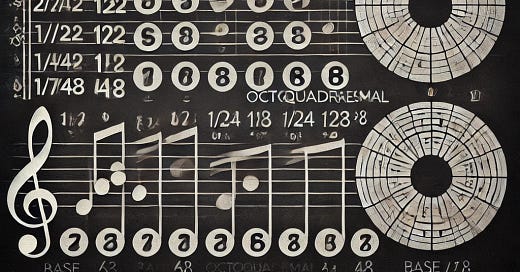Standardized Notation Symbols for Tetrasexagesimal and Octoquadragesimal Note Values
Introduction
With the integration of Tetrasexagesimal (Base 64) and Octoquadragesimal (Base 48) note values, a new system of notation is required to represent these rhythmic structures efficiently. This document outlines a standardized set of symbols that musicians can use in both written sheet music and digital music notation software.
Core Principles for the Notation System
Maintain Familiarity – The system should be easy to read and resemble traditional notation where possible.
Distinguish Binary and Ternary Note Values – Since Base 64 uses binary subdivisions and Base 48 uses ternary subdivisions, symbols should visually differentiate these.
Ensure Scalability – The notation should be extendable for complex rhythms and time signatures.
New Note Symbols
Tetrasexagesimal (Base 64) Binary Note Values
Octoquadragesimal (Base 48) Ternary Note Values
Note: Tetrasexagesimal notes (◉, ○, ◍, etc.) use circle-based symbols, while Octoquadragesimal notes (▲, △, ▼, etc.) use triangle-based symbols to differentiate their binary vs. ternary nature.
New Time Signature Notation
Instead of traditional time signatures like 4/4 or 6/8, the new notation system follows:
Tetrasexagesimal Time Signatures (Binary): 2/2, 4/4, 8/8, 16/16, 32/32
Octoquadragesimal Time Signatures (Ternary): 3/3, 6/6, 12/12, 24/24
To reflect this system visually:
Binary time signatures are enclosed in double lines (||).
Example: ||4/4|| (Tetrasexagesimal Common Time)
Ternary time signatures are enclosed in angled brackets (<>).
Example: <6/6> (Octoquadragesimal Compound Meter)
How to Use This System in Composition
DAW and Digital Integration – These note symbols and time signatures can be incorporated into digital audio workstations (DAWs) and sheet music software.
Handwritten Sheet Music – Musicians can easily differentiate binary vs. ternary rhythms by using the appropriate circle or triangle symbols.
Experimental Notation – This system allows for precise rhythmic experimentation beyond traditional notation.
Conclusion
This new standardized notation system ensures that musicians using Tetrasexagesimal (Base 64) and Octoquadragesimal (Base 48) rhythmic structures can notate their compositions with clarity and efficiency. Future expansions can include additional rhythmic elements and polyrhythmic integration.






